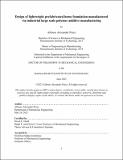Design of lightweight prefabricated home foundation manufactured via industrial large scale polymer additive manufacturing
Author(s)
Perez, Alfonso Alexander
DownloadThesis PDF (133.2Mb)
Advisor
Hardt, David E.
Terms of use
Metadata
Show full item recordAbstract
The mission of this thesis is to present a novel light-weight, low cost alternative to concrete foundations for dwelling home construction. Worldwide, UN HABITAT estimates suggest nearly 1.6 billion people lack access to adequate shelter including 150 million homeless individuals. Home affordability is limited by expensive materials that require transportation to emerging markets which oftentimes lack necessary infrastructure. Traditional home foundations exhaust local resources and strain local supply chain logistics networks due to their predominantly concrete composition. Concrete is also a major strain on the natural environment, alone accounting for ~8% of global CO2 emissions. Furthermore, concrete requires substantial water consumption, which is often impossible in areas that do not have consistent access to alkaline free water. Despite all the negative impacts of traditional concrete foundations, concrete is common in dwelling home construction due to the load bearing compressive strength. Without a durable foundation a dwelling home’s longevity and safety significantly decrease.
This thesis presents an analysis of conventional dwelling home foundation designs and the resulting consequences including, but not limited to, weight, cost, and environmental impact. With an analytical understanding of traditional foundation’s strengths and weaknesses, a novel sustainable prefabricated foundation design is presented that is intended to be made entirely of recycled thermoplastic polymers, namely polyethylene terephthalate (PET). The proof of concept prototypes of the prefabricated foundation are designed specifically for and made using industrial large scale polymer additive manufacturing. The novel prefabricated foundation is >10x lighter weight than a traditional concrete pad foundation and consumes ~0kg of water during production. This foundation design overcomes the negative impacts of traditional concrete foundations while simultaneously exceeding the core dwelling home foundation functional requirements.
Challenges in achieving this goal include: a) additively manufactured anisotropic mechanical properties, b) quasi-static mechanical performance of large scale additively manufactured recycled polymer structures, c) CAD for large scale additive manufacturing of polymers, d) structural finite element analysis of anisotropic large scale additive manufactured polymers, e) thermal distortion during manufacture, and f) design for the not well developed large scale additive slicer algorithms. . Full scale prefabricated foundation prototypes were produced and force-displacement tests were conducted. Five nearly full-scale (~8’x2’x1’) prototypes of the prefabricated additively manufactured polymer foundation product were produced. These were made from ABS/20% carbon fiber, weighed ~300 lb [135 kg] and were manufactured using a CI BAAM 806 system in under five hours. Force displacement testing using a Baldwin 300kN hydraulic force-displacement system revealed that at the extreme design load, 5,000 lb on the center column, that the displacement was less than 0.5 mm and the failure load was >60,000lb. It was shown that 1) the prefabricated foundation design is indeed manufacturable, 2) that the warping, shrinkage, flash, and layer delamination defects are seemingly inconsequential, and 3) that the prototypes provide a static loading safety factor on the order of 50x. This thesis demonstrates that a prefabricated volumetric modular polymer home foundation manufactured by industrial large scale polymer additive manufacturing is possible.
In addition to the novel prefabricated foundation product, this thesis presents a 12-step iterative design process that is useful for the efficient design of structures made via industrial large scale polymer additive manufacturing. The 12-step iterative design process presented herein proved to be a cost effective method designed to inexpensively and quickly de-risk subsequent design steps. The production rate (R), structural quality (Q), manufacturing cost (C), design flexibility (F), and process sustainability (S) of industrial large scale polymer AM was studied and presented using a physics informed causal loop diagram.
Date issued
2023-06Department
Massachusetts Institute of Technology. Department of Mechanical EngineeringPublisher
Massachusetts Institute of Technology